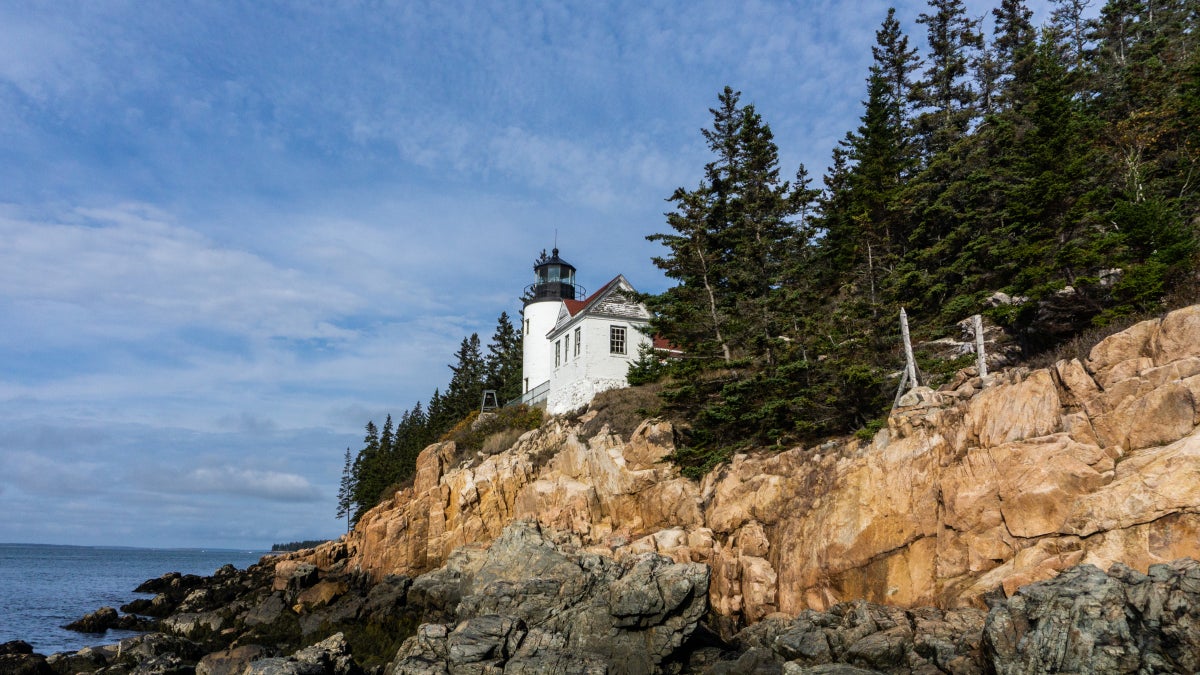No products in the cart.
Outdoor Adventure
The Best Adventures at Acadia National Park
Get full access to Outside Learn, our online education hub featuring in-depth fitness, nutrition, and adventure courses and more than 2,000 instructional videos when you
sign up for Outside+.
63 Parks Traveler started with a simple goal: to visit every U.S. national park. Avid backpacker and public-lands nerd Emily Pennington saved up, built out a tiny van to travel and live in, and hit the road, practicing COVID-19 best safety protocols along the way. The parks as we know them are rapidly changing, and she wanted to see them before it’s too late. Acadia is her 49th park visit.
I clutched a cold iron rung, glinting in the early sunlight, and felt my left hand slip on the mud of a previous hiker’s boot. I could feel my heartbeat quicken as I clambered for a better grip. My chest tightened. My stomach dropped. Below me was a near vertical cliff of over 300 feet, and I was now clinging one-handed to a lichen-speckled face overlooking the Atlantic.
Acadia National Park, in southeastern Maine, is famous for these sorts of death-defying hikes with commanding views of the wild ocean, also known as rung and ladder trails. When I met up with my friend J.C. to explore the area for a few days last October, the first stop on our list was also the most perilous. At 3.2 miles, the Precipice Loop might seem like a moderate day hike by most standards, but less than half a mile in, the trail transformed from dirt singletrack to a choose-your-own-adventure maze of car-size granite hunks and thin metal bars intended to serve as hand- and footholds. It startled me awake far more than my morning latte.

After gaining a thousand feet of elevation in under a mile, legs wobbly but no worse for wear, the two of us stood on the summit of Champlain Mountain, a tapestry of gold and blood-red trees hugging the gunmetal water of the rocky shoreline below. The next day, I mumbled to myself, would need to be more relaxing.
Home to 45 miles of crushed-stone carriage roads, a gift of John D. Rockefeller Jr. in the early 1900s, Acadia is a wonderland for cyclists looking to get off the beaten path and enjoy miles of car-free lanes bordered by hemlock, white birch, and maple. I rented a bike in Bar Harbor, a small, historic town enveloped by the park, and put my lungs to the test as J.C. and I set off from Jordan Pond on a 13-mile jaunt around wooded Sargent Mountain. As we ascended, the views down into glistening sapphire lakes were tremendous, but before long, my breath became ragged and my long-sleeved thermal was soaked through with sweat.
Wheels spinning, the wind whipped my hair around the plastic cage of my helmet as I eagerly zoomed across babbling streams and stony bridges to complete the loop. It was midafternoon by that point, and we were both fiending for a batch of Jordan Pond House’s famous popovers and jam. I hungrily slathered my two puffed rolls with butter and devoured them in a matter of minutes, crumbs and all. Though Acadia didn’t have the high-altitude peaks of my native California, the park was steadily impressing me with its diversity of recreational opportunities.
To cap off the trip, the two of us rose before dawn to watch the sun’s faint glow trace its way across island-strewn Frenchman Bay from the summit of Cadillac Mountain. The peak, which is the highest point along the eastern seaboard, also sees the country’s first rays of light from October to early March. Every morning, hundreds of travelers jockey for position to catch the show, and we were no different.
Bundled up and bleary-eyed, I leaned against a granite pillar and gazed out into infinity as the sky lit up like a Day-Glo Rothko painting—first periwinkle, then fuchsia, then bright amber. Shivering amid a crowd of strangers, I could sense that I was in the middle of a memory that would last a lifetime, waiting for the new glint of our closest star to gently warm my cheeks.
63 Parks Traveler Acadia Info
Size: 49,077 acres
Location: Southeastern Maine
Created In: 1916 (Sieur de Monts National Monument), 1919 (Lafayette National Park), 1929 (renamed Acadia National Park)
Best For: Hiking, sailing, coastal drives, rock scrambling, tide-pool viewing, cycling, history buffs
When to Go: Summer (53 to 79 degrees) offers warm weather and low precipitation, while fall (32 to 71 degrees) is popular with the leaf-peeping crowd. Winter (15 to 38 degrees) is quiet and perfect for snowshoeing the carriage roads, and spring (25 to 65 degrees) brings hundreds of wildflowers.
Where to Stay: Acadia operates four official campgrounds, two of which (Blackwoods and Seawall) are located on Mount Desert Island, near the main hub of the park. If you’re looking for a cozier stay with a hot shower, views of the Atlantic, and a primo free breakfast, check out the Hampton Inn Bar Harbor.
Mini Adventure: Watch the sunrise from the summit of Cadillac Mountain. Grab a vehicle reservation and set your alarm to catch the country’s first rays of light from the park’s high point, then steer your car down the paved slope and onto Park Loop Road, which affords stunning coastal views and easy access to highlights like Thunder Hole, Jordan Pond, and Otter Cliffs.
Mega Adventure: Hike one of Acadia’s rung and ladder trails. Though the Beehive Loop gets all the love on social media, the Precipice Loop is longer and far more scenic if you’re an experienced scrambler with a stomach for heights. Go before 10 A.M. to avoid the masses, and consider switching to a hike on the park’s carriage roads if there’s any chance of rain on the forecast. Afterward, indulge in the area’s most famous delicacy—a lobster roll—at Stewman’s Lobster Pound. You’ve earned it.

